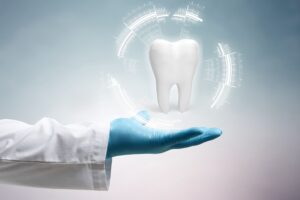Mending Damage: Do I Need a Filling or a Dental Crown?
April 6, 2024

If you’ve been suffering from a persistent toothache and visit your dentist, there’s a good chance that they’ll suggest either a dental filling or crown to repair and protect it. These restorative methods allow them to preserve your natural tooth, which is usually better for your oral health than extracting and replacing it.
But how do you know which treatment is right for your situation? Your dentist will examine your mouth first and make a recommendation depending on the severity of your condition. Continue reading to learn more about both solutions so you can make a well-informed decision when the time comes!
What is a Filling?
A dental filling is a technique in which your dentist applies layers of tooth-colored resin directly to your damaged pearly white to fill in any cavities. Then, they harden it in place with a special curing light so that it bonds with your enamel to support its structure. The procedure can often be completed in a single hour-long visit, and the results last 10+ years if you practice consistent dental hygiene at home.
When Are Fillings Best?
This is the default way to repair cavities but isn’t effective if your tooth is more severely injured. That means it’s best for those with more minor instances of decay. Also, because the composite resin relies on your tooth’s structure for stability, if it’s cracked, then it won’t be effective. In time, the pressure of biting down could cause the hardened material to expand any fractures. As a result, fillings are ideal when the decomposed area is smaller and self-contained. Plus, it can last 20+ years if it’s properly maintained.
What is a Dental Crown?
Dental crowns are artificial teeth typically made from durable, color-matched porcelain that’s bonded over your injured tooth. It acts like a shield to keep bacteria out and allows you to keep your pearly white when it might otherwise require removal. It can be used to protect overly deteriorated, worn down, broken, or root-canal-treated teeth. It’s also often used to cover dental implants when a replacement is required.
When Are Dental Crowns Best?
Your dentist might recommend this option if you’ve sustained more damage than a filling can repair. If your tooth is fractured or if a large portion is destroyed by decay, then this is a great way to restore its functionality. Not only does it allow you to continue using it normally, but it also ensures that it’s less likely to sustain further harm later.
In some cases, dental crowns are also used for cosmetic purposes, like covering a misshapen tooth or one with internal stains that can’t be whitened.
Either way, your dentist will work with you on an appropriate solution to repair your smile so you can continue to make the most of it!
About the Author
Dr. Brent Cline is a skilled dentist who offers a wide variety of services under one roof to meet all your family’s oral healthcare needs, including fillings and dental crowns. He earned his undergraduate degree in business at Brigham Young University-Idaho and then pursued his dental degree at Creighton University in Omaha, NE. He then completed an advanced training program in General Dentistry at ISU in Pocatello where he learned how to use state-of-the-art technology to rebuild smiles. That means if you have a damaged tooth that needs repair, he’s an expert you can trust to help you. If you’d like to schedule an appointment, you’re welcome to contact the office through the website or by calling (208) 487-5987.

